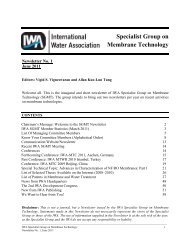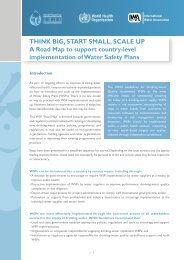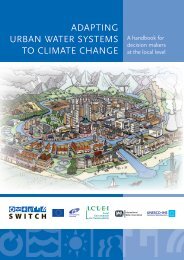Sanitation 21 planning framework - IWA
Sanitation 21 planning framework - IWA
Sanitation 21 planning framework - IWA
- No tags were found...
You also want an ePaper? Increase the reach of your titles
YUMPU automatically turns print PDFs into web optimized ePapers that Google loves.
<strong>Sanitation</strong> <strong>21</strong>• Do management requirements match? (Are thereinstitutions – people, skills, money – available todo what is needed to keep the system working ineach domain?)• Will it/ does it work?This final question is one which is asked less oftenthan it should be.The process is shown graphically in Table 7 (a)-(c) which shows a blank notional <strong>framework</strong>. Wewould however like to emphasise again that theprocess itself may be complex and varied and thereality is by no means captured on a table printedon a single A4 sheet. A more comfortable way toillustrate the <strong>framework</strong> is through the use of casestudies and it is to these that we turn in the nextsection.4.3 Case Study ExamplesThe Task Force are developing a series of casestudies to demonstrate the usefulness of the<strong>framework</strong> developed here. Until these arecompleted the following sections provide somebrief examples of how the <strong>framework</strong> has beenused, utilising some sample cases. .Post Conflict KabulOne of the worse-case scenarios of sanitation<strong>planning</strong> arises in situations where existinginfrastructure and institutions are badly damagedand the urban situation is in a state of insecurityand flux. An example in recent years is postconflictKabul where, in 2002, there was little or nosanitation provision but an urgent need to provideaccess to basic services. The existing pipedsewerage network had been severely damagedand in any case served a very small portion of thecity. Meanwhile many of the traditional dry toiletshad fallen out of use because of disruption to thetraditional agricultural market for solid wastes.This disruption arose because of both insecurityand also because introduction of cheap chemicalfertilisers had severely depressed demand.Furthermore in-migration to the city was happeningat a rapid rate but the urban authorities werebarely in existence and struggling to manage evenbasic day to day urban service delivery.In such cases it is not untypical to find‘conventional’ systems being promoted orselected for rehabilitation simply because thereis no capacity to analyse and understand anolder existing or traditional system and certainlyno capacity to deal with the rapid changes inconditions. In Kabul this was indeed the case,with consultants recommending rehabilitation ofthe sewerage network serving an estimated 5% ofthe population but unable to propose any effectivemeans of delivering services to the peripheralurban areas, low income settlements, high densityhousing or hilly locations. The consultants andtheir clients exhibited an unwillingness or inabilityto analyse how interventions in the agriculturalmarket and attention to people’s own culturalpreferences could lead to an alternative, moreflexible and disaggregated solution. A focuson conventional technologies appeared tocompromise the consultants’ ability to make moreradical suggestions while pressures both fromadministrators and technicians biased the initialanalysis in favour of investments in wastewatertreatment and trunk sewerage.In such a case use of the <strong>framework</strong> could haveshown how local solutions could work in substantialareas of the city; subsequent work supported bythe World Bank and reinforcing excellent workalready undertaken by ICRC amongst many othershas resulted in the proposition of more effectiveoptions for various areas of the city; it remains tobe seen whether these meet the ‘objectives’ of thecity administrators and the international donorswho will be providing financial support.Small Town realities in Bharatpur, IndiaIn the late 1990s the Water and <strong>Sanitation</strong> Program(WSP) worked with the municipal government ofBharatpur, a ‘small’ Indian town with a populationof around 200,000 people, to develop a ‘Strategic<strong>Sanitation</strong> Plan’. Bharatpur is a site of interest totourists due to a large and unique bird reserve on itsoutskirts and a number of historic buildings in thecity itself. However the sanitation situation of the citywas extremely poor, with many families relying onbadly-maintained septic tanks and pour-flush latrinesand widespread incidence of open defecation.Furthermore the city was subject to periodic severeflooding, particularly in the area around a central‘fort’ and its moat, the Sujjan Ganga.A recent report summarised some of the interests– 29 –
















